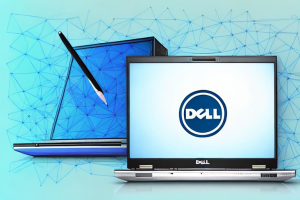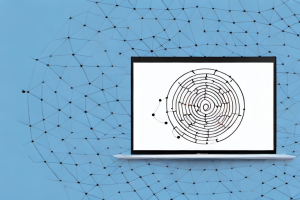How to fix a black screen after sleep mode on a Dell XPS 13 9365
7 min read
A dell xps 13 9365 laptop with a black screen
If you own a Dell XPS 13 9365, you might have experienced a frustrating issue where your laptop screen goes black after waking up from sleep mode. This problem can occur due to various reasons, such as a driver issue, BIOS settings, or a faulty display. In this article, we’ll explore the possible causes of this problem and provide you with a step-by-step guide on how to fix it.
Understanding the black screen issue on a Dell XPS 13 9365
Before we dive into the solutions, it’s essential to understand the problem in detail. When you put your Dell XPS 13 9365 in sleep mode, the laptop goes into a low-power state, where it conserves battery by turning off the display and other components. When you wake up your machine from sleep mode, the screen turns on and displays your desktop or login screen. However, sometimes, the screen remains black, and you’re unable to do anything.
One of the main causes of the black screen issue on a Dell XPS 13 9365 is outdated or corrupted graphics drivers. Graphics drivers are responsible for displaying images on your screen, and if they’re not functioning correctly, it can cause the screen to remain black. Updating your graphics drivers to the latest version can often resolve this issue.
Another possible cause of the black screen issue is a hardware problem. If your laptop has suffered physical damage or has a faulty component, it can cause the screen to remain black. In this case, you may need to take your laptop to a professional technician for repair.
Common causes of the black screen issue on a Dell XPS 13 9365
There are several reasons why your Dell XPS 13 9365 might be experiencing a black screen issue after waking up from sleep mode. Some of the most common causes include outdated drivers, BIOS settings, hardware issues, or an operating system glitch.
One of the most common causes of the black screen issue on a Dell XPS 13 9365 is outdated drivers. If your drivers are not up to date, it can cause conflicts with the operating system and lead to a black screen issue. It is important to regularly check for driver updates and install them as soon as they become available.
In addition to outdated drivers, BIOS settings can also cause the black screen issue. If the BIOS settings are not configured correctly, it can cause conflicts with the operating system and lead to a black screen issue. It is recommended to reset the BIOS settings to default and then configure them according to your preferences.
Troubleshooting tips for a black screen after sleep mode on a Dell XPS 13 9365
If you’re experiencing a black screen after waking your Dell XPS 13 9365 from sleep mode, try these troubleshooting tips:
1. Press any key or move the mouse
It’s possible that your laptop’s screen hasn’t fully woken up from sleep mode. Try pressing any key or moving the mouse to wake up the screen. If this doesn’t work, move on to the next solution.
2. Disconnect and reconnect external devices
If you have any external devices connected to your laptop, such as a USB drive, printer, or docking station, disconnect them and see if the screen comes back on. Sometimes, an external device can cause compatibility issues with your laptop, leading to a black screen issue.
3. Force restart your laptop
If your Dell XPS 13 9365 is still stuck on a black screen after trying the above solutions, force restart your laptop by pressing and holding the power button. After restarting, try waking up your laptop from sleep mode again.
4. Update your graphics driver
If your Dell XPS 13 9365 is still experiencing a black screen after trying the above solutions, it may be due to an outdated or corrupted graphics driver. Go to the Dell website and download the latest graphics driver for your laptop model. Install the driver and restart your laptop to see if the issue is resolved.
5. Check for Windows updates
It’s possible that a Windows update may have caused the black screen issue. Check for any available updates by going to Settings > Update & Security > Windows Update. Install any available updates and restart your laptop to see if the issue is resolved.
Step-by-step guide to fix a black screen after sleep mode on a Dell XPS 13 9365
If none of the above solutions work, you can try the following step-by-step guide to fix the black screen issue on your Dell XPS 13 9365:
Step 1: Update your laptop’s drivers
Outdated drivers can cause compatibility issues with your laptop and lead to a black screen issue. To update your drivers, follow these steps:
- Go to the Start menu and type “Device Manager” in the search bar.
- Select “Device Manager” from the search results.
- Expand the categories of the device you want to update.
- Right-click on the device and select “Update driver”.
- Follow the instructions on-screen to update the driver.
Step 2: Check your BIOS settings
Your laptop’s BIOS settings can also affect the performance of your device. To access your BIOS settings, follow these steps:
- Restart your laptop and keep tapping the F2 key to enter the BIOS setup utility.
- Navigate to the “Power Management” section.
- Disable “Deep Sleep” and “Modern Standby” options.
- Save the changes and exit the BIOS setup utility.
Step 3: Perform a system restore
If updating your drivers and changing your BIOS settings doesn’t fix the issue, perform a system restore to revert your laptop to an earlier state when it was working correctly. To perform a system restore, follow these steps:
- Go to the Start menu and type “Control Panel” in the search bar.
- Select “Control Panel” from the search results.
- Click on “System and Security”.
- Click on “System”.
- Select “System Protection” from the left-hand side menu.
- Click on “System Restore”.
- Follow the instructions on-screen to complete the system restore.
It is important to note that performing a system restore will revert your laptop to an earlier state, which means that any changes made after that point will be lost. Therefore, it is recommended to create a backup of your important files and data before performing a system restore.
How to update drivers to prevent black screen issues on Dell XPS 13 9365
Updating your Dell XPS 13 9365’s drivers is an excellent preventative measure to avoid black screen issues in the future. To update your drivers, follow the steps outlined in the step-by-step guide mentioned above. Make sure to keep your drivers up-to-date to ensure your laptop functions smoothly.
In addition to preventing black screen issues, updating your drivers can also improve the overall performance of your Dell XPS 13 9365. Outdated drivers can cause slow performance, crashes, and other issues. By keeping your drivers up-to-date, you can ensure that your laptop runs smoothly and efficiently.
It is also important to note that updating your drivers can sometimes fix other issues that you may be experiencing with your Dell XPS 13 9365. For example, if you are having trouble connecting to Wi-Fi or Bluetooth devices, updating your drivers may solve the problem. Therefore, it is always a good idea to check for driver updates regularly, even if you are not experiencing any issues.
Ways to prevent the black screen issue from happening again on your Dell XPS 13 9365
Here are some ways to prevent the black screen issue from happening again on your Dell XPS 13 9365:
- Make sure your laptop’s drivers are up-to-date.
- Don’t keep your laptop in sleep mode for an extended period. Consider shutting it down or turning it off when not in use.
- Disable unnecessary startup programs to reduce the load on your laptop’s processor.
- Keep your laptop’s BIOS settings up-to-date.
In addition to the above mentioned ways, it is also recommended to clean your laptop’s fan and vents regularly to prevent overheating. Overheating can cause the black screen issue and other hardware problems. You can use compressed air or a soft brush to clean the fan and vents. It is also important to avoid using your laptop on soft surfaces like beds or couches, as they can block the vents and cause overheating.
Understanding the BIOS settings and how it can be related to the black screen issue
The BIOS (Basic Input/Output System) is a set of firmware instructions present on your laptop’s motherboard. It’s responsible for managing your laptop’s hardware and starting up your operating system. Sometimes, outdated or incorrect BIOS settings can lead to a black screen issue on your Dell XPS 13 9365. To prevent this, make sure to keep your BIOS settings up-to-date.
Additionally, it’s important to note that changing BIOS settings without proper knowledge or guidance can also cause the black screen issue. It’s recommended to consult the manufacturer’s website or a professional technician before making any changes to the BIOS settings. This will ensure that the settings are optimized for your laptop’s hardware and prevent any potential issues.
What to do when all else fails: Contacting technical support for your Dell XPS 13 9365
If you’re still unable to fix the black screen issue on your Dell XPS 13 9365, it’s time to reach out to technical support. Dell has an extensive technical support team that can assist you in resolving any issues with your laptop. You can reach out to Dell’s technical support team through their website, email, or phone.
In conclusion, a black screen issue after sleep mode on a Dell XPS 13 9365 can be frustrating, but it’s not impossible to fix. By following the troubleshooting tips and step-by-step guide mentioned above, you can get your laptop up and running in no time.
It’s important to note that before contacting technical support, you should ensure that your laptop is still under warranty. If it is, Dell’s technical support team can provide you with free assistance and even replace any faulty hardware if necessary. However, if your laptop is no longer under warranty, you may have to pay for any repairs or replacements needed. It’s always a good idea to check your warranty status before reaching out to technical support.


